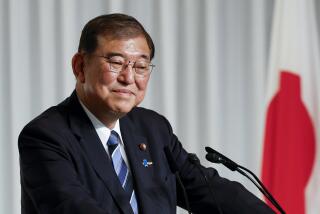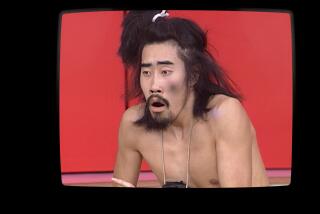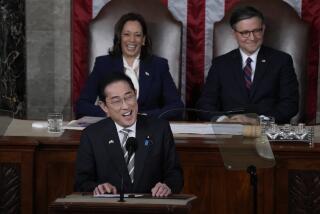Takeshita Bringing âPolitics of Waitingâ to Top Japanese Post
TOKYO â Noboru Takeshita, who was designated Monday as Japanâs next prime minister, describes himself as a politician committed to a âripe persimmonâ brand of politics.
In Japan, that means he is the kind who prefers to wait for the fruit to fall ripe from the tree rather than to reach up and pluck it.
âIt may be strange to say it myself, but I have never gotten angry,â Takeshita once said. âTo contain anger is to overcome oneself. And it isnât an easy thing to do.â
Caution and patience, even to the point of indecisiveness, have become hallmarks of Takeshita, the eldest son of a brewer of sake, or rice wine, who was born in a mountain village on the far side of Japan near the Sea of Japan.
Takeshita, 63 and secretary general of the ruling Liberal Democratic Party, had those traits, villagers recall, even before he was elected to the Shimane prefecture assembly in 1951 at the age of 27.
But after moving up to the lower house of Parliament in 1958, Takeshita said, he learned from Prime Minister Eisaku Sato âthe politics of waitingâ--doing nothing until a consensus emerges. Sato, who died in 1975, was prime minister for seven years and eight months, longer than any other post-World War II leader.
Takeshita, in an interview with the newspaper Yomiuri, quoted Sato as often saying: âMan has two ears but only one mouth. Listen to what others say twice as much as what you say to them.â
âThe Silent Takeshitaâ
He has taken Satoâs advice to heart so thoroughly that Japanese newsmen call him âthe silent Takeshita.â He is also known as one of Japanâs most inarticulate speakers.
How Takeshita will get along with U.S. officials in the aftermath of the first-name relationship that the outspoken and decisive Prime Minister Yasuhiro Nakasone established with President Reagan is a matter of concern to many Japanese.
âPatience is not an American virtue, and speed is not a Japanese one, but more of both are needed,â U.S. Ambassador Mike Mansfield observed two weeks ago.
Yet Takeshita, who will be elected prime minister by Parliament on Nov. 6, will bring to the job a free hand to deal with policies of concern to the United States.
Unlike the highly popular Nakasone, who rode into office partly on the strength of a policy of administrative reform and belt-tightening--and felt compelled to stick to it long after it contributed to Japanâs mounting trade surplus problems, Takeshita carries no policy or philosophical baggage.
Greater Domestic Growth
One Takeshita goal appears to be to mesh with American calls for Japan to seek greater economic growth at home, rather than through exports.
As part of his quest for the prime ministerâs job, Takeshita announced a program to transform the entire Japanese archipelago into âa hometownâ by spreading urban-like conveniences, access to cultural activities and job opportunities throughout the country.
A consensus has already emerged for action as more and more Japanese are complaining that their country--the worldâs largest capital-exporter, with a per-capita gross national product that is expected to exceed that of the United States this year--is a ârich country with poor people.â The standard of living is still a mere shadow of that in middle-class America, they say.
Unlike Nakasone, who never controlled a personal following that gave him a hold on power within the ruling party, Takeshita is the leader of the partyâs largest faction and so has a base on which he can build his own policies, if he chooses to do so. His 113 followers represent more than a quarter of the partyâs members in both houses of Parliament.
On Tuesday, in his first press conference as prime minister-designate, Takeshita promised to tackle tax reform, the issue that brought Nakasone his most important defeat in five years as prime minister, along with American-Japanese economic friction, skyrocketing land prices, and problems arising from the conflict in the Persian Gulf.
As for details, he continues to be an unknown commodity.
Even on some major issues, such as national defense, Takeshita has never publicly expressed a personal opinion, or displayed any knowledge that goes beyond the ruling partyâs official support for the U.S.-Japan Security Treaty.
Accused of lacking policies or a philosophy of his own, Takeshita defends himself unabashedly. In an age of pluralistic interests, he has said, a man such as he, capable of coordinating conflicting demands, is precisely the kind of leader Japan needs.
But his naivete on diplomatic issues frightens critics. When a foreign correspondent asked him to comment on anti-Chinese demonstrations in Tibet earlier this month, Takeshita replied, âOn issues on which I have no knowledge, I would like to reserve my comment.â
Indecisiveness a Worry
Others are upset by his indecisiveness.
Languishing for years in the shadow of former Prime Minister Kakuei Tanaka, his mentor, Takeshita finally decided in 1985 to establish a power base of his own, but he prepared for the move in secret, without informing Tanaka.
Tanaka flew into a rage when he heard about Takeshitaâs plans to establish a âstudy groupâ and condemned it as âa faction within a factionâ--an affront to his leadership. But Takeshita went ahead and set up the group in February, 1985. Later, he curtailed the groupâs activities and then dissolved it altogether.
Just 20 days after Takeshita established the group, Tanaka suffered a stroke that Tanaka loyalists blamed on Takeshitaâs defiance. Tanaka has not forgiven him. Twice this year, the ailing politician turned Takeshita away when he tried to pay his respects at Tanakaâs home.
Tanaka still holds a seat in the lower house of Parliament, though he has not been seen in public since his stroke.
Named to High Post in 1964
Takeshita made his first appearance in the national limelight in 1964, when Sato named him his deputy chief Cabinet secretary. Sato later appointed him chief Cabinet secretary, as did Tanaka.
The chief secretary coordinates the activities of government ministries, and Takeshita developed a following of his own by doing favors for fellow members of the Tanaka faction. He also learned from Tanaka the techniques of election management, the ways to use money and how to deploy personal ties to political advantage.
A close relationship with one of the ruling partyâs master âfixers,â Shin Kanemaru, now deputy prime minister, also has helped him immensely. Kanemaruâs eldest son is married to Takeshitaâs eldest daughter.
Skillful in what is known as nemawashi --building foundations on which to make decisions--and known as a man who pays careful attention to the feelings of those who can help him, Takeshita has said he follows the principle of âI do the sweating and give others the triumphs.â
These qualities have given Takeshita the best relations with leaders of opposition parties that any conservative politician enjoys today. These relations are based to some extent on old school ties, for many opposition chiefs, like Takeshita, are graduates of Waseda University.
Takeshita is also one of the ruling partyâs top fund-raisers. Last May he put on a $200-a-ticket reception that raised 2 billion yen ($14.3 million) in two hours. The reception attracted more than 13,000 people.
He has no wide contacts in the business community. His strongest ties are with executives in the securities and construction business, men he met while serving as construction minister and finance minister.
Slight in stature--he stands 5 feet 5 inches and weighs 143 pounds--Takeshita calls golf his favorite participatory sport and confesses to a handicap of 28. A former judo coach, he also likes to watch sumo and baseball.
Asked by a Japanese reporter what book he had read recently, he replied, âNothing.â
Takeshita was drafted a year before World War II ended and was attached to an army flight squadron when Japan was defeated. Before entering politics, he taught English at a junior high school, though he confesses that he cannot speak English.
As prime minister, Takeshita said, he intends to combine some of Nakasoneâs attributes with his own.
Noting that the outgoing prime minister was a middle-distance runner in high school, he said: âMy specialty was judo. Therefore, whereas Nakasone tried to do things stride-by-stride, I intend to move forward step-by-step, at least domestically. But on international issues, I will move stride-by-stride.â
He has echoed Nakasone statements that the Japanese people must undergo âa transformation of thinking.â The Japanese, he has said, must come to realize âon their own, not because they are told by foreign countries, that an open market is only natural . . . for Japan, a nation that has come to enjoy prosperity because of free trade.â
Contrast With Nakasone
One of Takeshitaâs greatest difficulties, many analysts agree, will be in following the footsteps of Nakasone, who brought to the Japanese people and to foreign leaders a new image of what a Japanese prime minister can be.
âIn one stroke,â the newspaper Asahi said, âhe overturned the passive image of Japanese prime ministers.â
A Japanese diplomat said, âHe was the first to put a face on Japanâs diplomacy.â
Japanese analysts and foreign diplomats alike fear that Takeshita may restore the old image and remove the new face.
More to Read
Sign up for Essential California
The most important California stories and recommendations in your inbox every morning.
You may occasionally receive promotional content from the Los Angeles Times.










